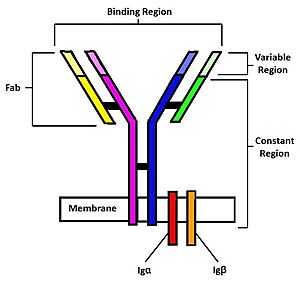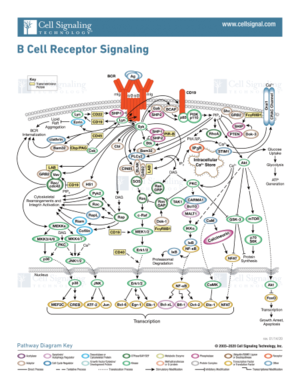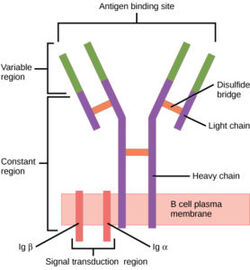Sandbox Reserved 1773
From Proteopedia
Contents |
H. sapiens mIgM B Cell Receptor
| |||||||||||
Medical Relevancy
Janeway CA Jr, Travers P, Walport M, et al. Immunobiology: The Immune System in Health and Disease. 5th edition. New York: Garland Science; 2001.
Disease
B-cells and their respective receptors play an important role in the immune response. Therefore, if the receptors were to not function properly, there would be damaging consequences. Autoimmune disease is suggested to occur when somatic cells are recognized as foreign antigens and the body tries to eliminate them. Although the exact mechanism of disease has not been provided, it is thought that B-cell receptors are an essential part of these diseases due to their function and role in the immune systems. B-cell receptors are improperly recognizing somatic cells from different tissues depending on the disease and elicit the production of antibodies against them (autoantibodies). This causes destruction of these cell types. Examples of these diseases include rheumatoid arthritis where the lining of joints is targeted and degraded, multiple sclerosis which targets the myelin sheath that surrounds nerve cells, type 1 diabetes mellitus where the insulin producing cells are targeted for destruction, and systematic lupus erythematosus where multiple organ systems are targeted (skin, brain, lungs, and kidneys are common targets).
Therapeutics
Additionally, B-cells have been studied in use for other therapies. For instance, research on mice has shown that manipulation of the genetic composition of their epitope region to recognize an antigen specific to cancer cells, reduced overall tumor size [2]. Furthermore, the B-cell signal pathway has been researched as a target in therapies for Chronic Lymphocytic Leukemia (CLL). This disease arises from the overproduction of B-cell and other immune cells that are nonfunctional. Research regarding this pathway has focused on producing antagonists for certain kinases that cause this over proliferation of cells and has had initial success [3]. The engineering of B-cells and manipulation of its biochemical pathway has promising uses in medicine.
B Cell formation/ function
Structure Summary The BCR is anchored to the membrane through the transmembrane regions and its interactions. Upon antigen binding, the BCR will undergo a unique structural conformation change that will allow transmission of the signal through the extracellular regions and the cell membrane to elicit an intracellular response. Interaction with a foreign antigen occurs at hyper-variable loop regions and causes the separation of Fab fragments (citation). This structural, conformational change will be transmitted through the heavy chains to the interface of heavy chain 1 and the Iga/ Igb complex. A shifting of interactions and overall conformational changes due to binding will then carry the signal through the Iga/ Igb complex through the membrane and into the cell. This will trigger intracellular signaling that will elicit subsequent production of free antibodies to recognize and target the foreign antigen. Therefore, any improper functioning of one of these regions will lead to improper functioning of the BCR and lessen the immune response as a whole.
3D structures of the BCR
References
- ↑ 1.0 1.1 1.2 1.3 1.4 Janeway CA Jr, Travers P, Walport M, et al. Immunobiology: The Immune System in Health and Disease. 5th edition. New York: Garland Science; 2001.
- ↑ Page A, Hubert J, Fusil F, Cosset FL. Exploiting B Cell Transfer for Cancer Therapy: Engineered B Cells to Eradicate Tumors. Int J Mol Sci. 2021 Sep 16;22(18):9991. doi: 10.3390/ijms22189991. PMID: 34576154; PMCID: PMC8468294.
- ↑ Woyach JA, Johnson AJ, Byrd JC. The B-cell receptor signaling pathway as a therapeutic target in CLL. Blood. 2012 Aug 9;120(6):1175-84. doi: 10.1182/blood-2012-02-362624. Epub 2012 Jun 19. PMID: 22715122; PMCID: PMC3418714.



